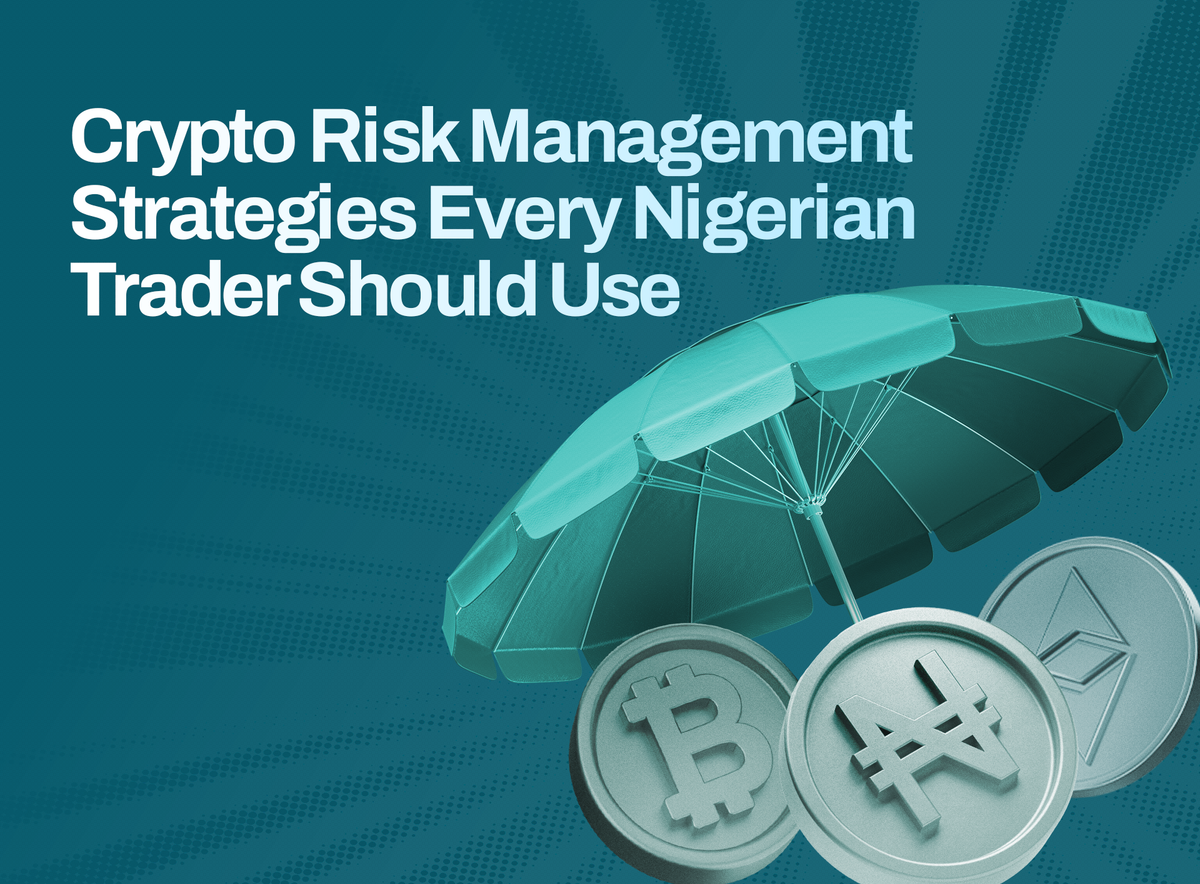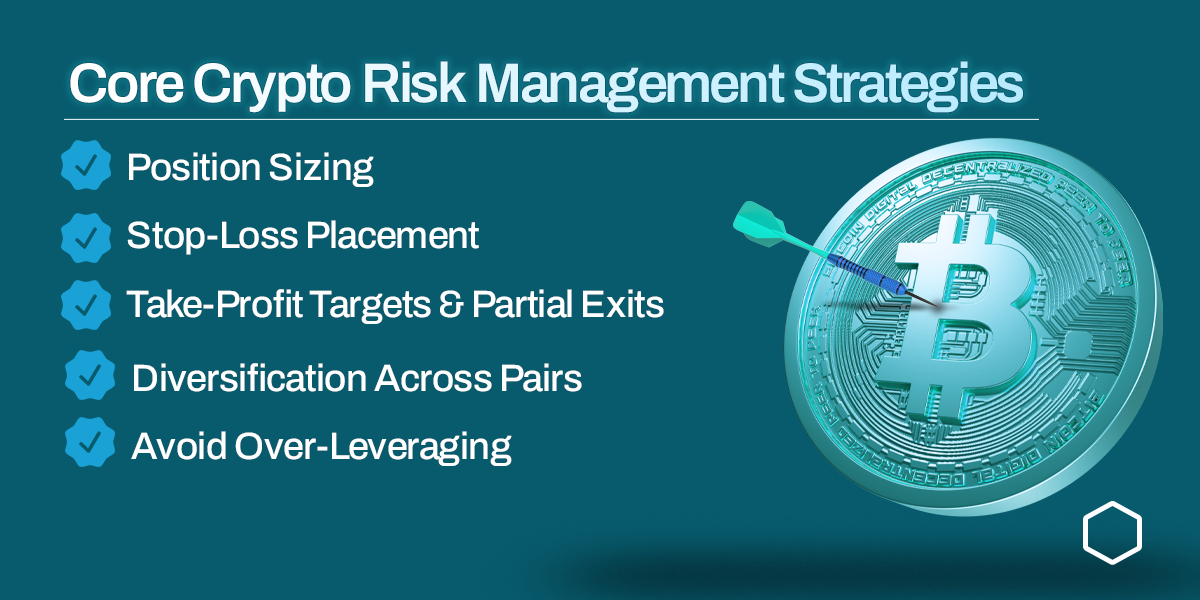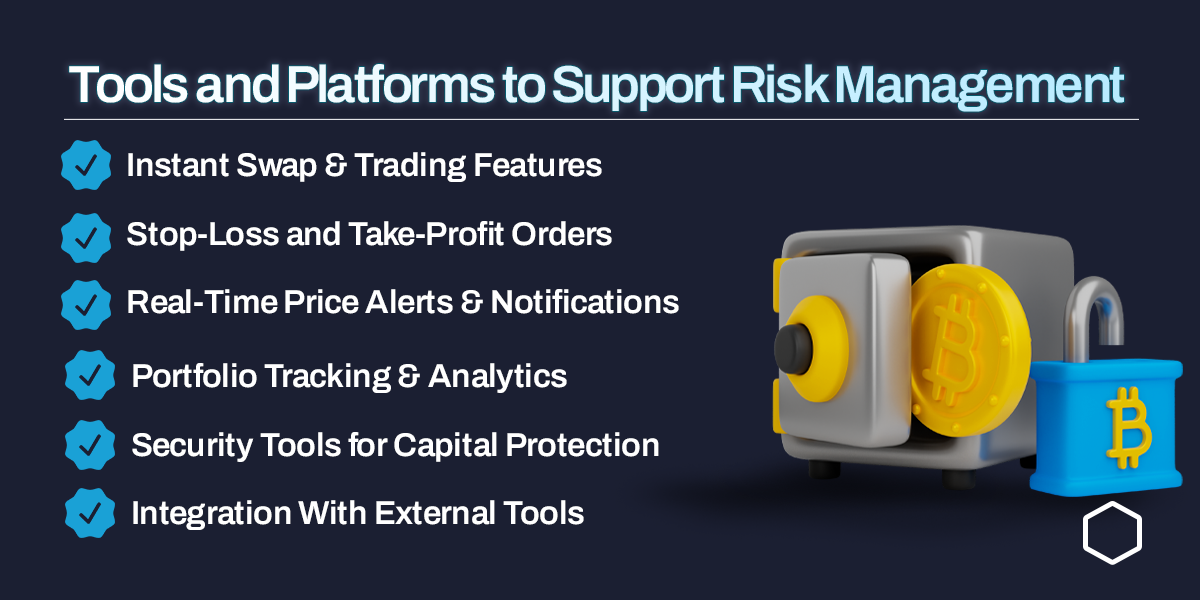Crypto Risk Management Strategies Every Nigerian Trader Should Use
Protect your capital and trade smarter. Learn actionable crypto risk management strategies every Nigerian trader should use, with real examples and step-by-step guidance.

Table of Contents
- Core Crypto Risk Management Strategies
- Risk Management in Action: Mini Case Studies
- Tools and Platforms to Support Risk Management
- Common Mistakes to Avoid
- To Recap
- FAQ
In crypto trading, profits can come quickly, but losses can wipe out your account just as fast, especially for Nigerian crypto traders, who face additional volatility from local factors such as currency fluctuations and market surges.
In cases like this, risk management isn’t optional. It’s how you survive.
Here are some strategies to protect your profits and minimise losses in crypto trading.
Core Crypto Risk Management Strategies
1. Position Sizing: Decide How Much to Risk per Trade
Why This Matters:
Putting too much money in a single trade is the fastest way to empty your account. Position sizing simply means deciding how much of your total capital to risk on each trade.
Step-by-Step Strategy:
1. Calculate your total trading capital.
- Example: ₦1,000,000.
2. Pick a risk percentage: 1–5% is a good range.
- At 2% risk, you would only risk ₦20,000 on one trade.
3. Adjust for volatility.
- If you’re trading a highly volatile coin, like a small-cap altcoin, risk less than you would on BTC or ETH.
Quick Checklist: ✅ Know your account size. ✅ Risk 1–5% per trade. ✅ Cut size for high-volatility coins.
This way, a single loss won’t drain your whole account, and you’ll still have capital to trade tomorrow.
2. Stop-Loss Placement: Limit Losses Automatically
Why This Matters:
A stop-loss is an order that closes your trade if the price moves against you. Basically, it’s an emergency exit that locks in a small, controlled loss before it becomes a disaster.
How to Set It:
- Use technical levels such as recent support zones on the chart.
- Or set a percentage rule; for example, 2–3% below your entry price.
Example:
You buy BTC at $110,000 and set a stop-loss at $108,800 (about 1.09% below). If the BTC price drops suddenly, your position will close automatically.
Obiex Advantage:
On Obiex, you can place stop-loss orders instantly, so even a sudden Naira swing or global market dump won’t catch you unprepared.
3. Take-Profit Targets & Partial Exits: Secure Your Gains
Why it Matters:
Crypto prices often rise fast and reverse just as quickly. A take-profit target ensures you lock in profit before the market turns.
Practical Approach:
- Set multiple targets. Sell part of your position as the price climbs.
- Example: Buy ETH at $3,000 → Sell 25% at $3,300 → Another 25% at $3,600.
This “scale out” method protects profits and reduces emotional decisions.
Pro Tip:
Use Obiex to place staggered sell orders so your profits are taken automatically.
4. Diversification Across Pairs: Don’t Put All Your Eggs in One Coin
Why This Matters:
Holding only one coin is like betting everything on a single football match. You win or lose it all at once. Diversification spreads risk.
How to Do It:
- Mix stablecoins like USDT or NGNX with major coins like BTC and ETH.
- Add small, calculated positions in altcoins if you want more growth potential.
Example:
Instead of putting ₦500,000 all in BTC, split it into ₦200,000 BTC, ₦200,000 ETH, and ₦100,000 USDT. A BTC drop will hurt less.
Obiex Advantage:
You can instantly swap between BTC, ETH, USDT, and NGNX to keep your portfolio balanced without waiting for long order-book delays.
5. Avoid Over-Leveraging: Keep Borrowed Risk Low
Why This Matters:
Leverage lets you trade with borrowed funds, which is great for magnifying profits, but it also multiplies losses. A 10x leverage trade can be liquidated by just a 10% move against you.
Best Practice:
- For most retail traders, 1x–3x leverage is plenty.
- Never risk more than your set percentage of capital on a leveraged trade.

Risk Management in Action: Mini Case Studies
It’s one thing to read about risk management rules, but it’s another to see how they play out in real trading situations.
Below are two hypothetical examples that show exactly how good (and bad) risk management can impact Nigerian crypto traders.
Case Study 1:
Trader Profile
- Name: Ada
- Experience: 18 months trading BTC/USDT
- Total Trading Capital: ₦2,000,000
- Risk Tolerance: 2% per trade (₦40,000)
- Platform: Obiex
Trade Setup
- Coin Pair: BTC/USDT
- Entry Price: $100,000
- Position Size: ₦400,000 (20% of her account)
- Stop-Loss Order: $98,000 (≈2% below entry)
- Take-Profit Targets: $103,000 and $106,000 for partial exits
Key Takeaways
- Position Sizing Worked: Ada traded only 20% of her account and risked 2%, keeping her loss small.
- Stop-Loss Saved Capital: The automatic sell order locked in a minor loss before it could spiral.
- Emotional Control: Knowing her risk upfront, Ada avoided panic and didn't engage in “revenge trade.”
- Platform Advantage: Obiex executed the stop-loss instantly, even as prices dropped sharply.
Case Study 2:
Trader Profile
- Name: Tunde
- Experience: 6 months trading various altcoins
- Total Trading Capital: ₦1,000,000
- Risk Tolerance: Undefined
- Platform: Another local exchange (manual trades only)
Trade Setup
- Coin: A high-volatility altcoin (not BTC or ETH)
- Entry Price: ₦2,000 per token
- Position Size: ₦500,000 (50% of account)
- Leverage: 10x (₦5,000,000 effective position)
- Stop-Loss: None
Market Conditions
The coin had been trending up, and social media hype was strong. Tunde wanted quick profits and entered late, expecting the momentum to continue.
What Happened
A negative market signal hit, and the altcoin’s price dropped 15% in under 30 minutes.
With 10x leverage, a 10% price drop equals a 100% loss on the leveraged amount. The 15% fall meant his position was liquidated almost immediately.
Outcome
- Capital Lost: ₦500,000 (half of his total account).
- Psychological Impact: Tunde panicked and attempted to recover by opening more trades, leading to more small losses.
- Remaining Capital: ₦500,000; he now needs a 100% return just to break even.
Key Takeaways
- Over-Leveraging Backfired: 10x leverage amplified a normal dip into a total wipeout.
- No Stop-Loss, No Protection: Without an automatic exit, Tunde’s trade had no safety net.
- Risk Mismanagement: Putting half his account in a single high-volatility altcoin was reckless.
Tools and Platforms to Support Risk Management
1. Instant Swap & Trading Features:
Why it matters:
When the market turns suddenly, you need to move funds between assets ( BTC to USDT or NGNX) without delay. Slow execution can turn a slight dip into a significant loss.
How Obiex helps:
- Instant Swaps: Convert BTC, ETH, or NGNX to stablecoins in seconds, avoiding long order-book waits.
- Low-Fee Transactions: Reduce slippage and keep more of your profits.
- 24/7 Trading: Respond to global market moves at any hour, even during high Naira volatility.
2. Stop-Loss and Take-Profit Orders:
Why it matters:
Manual selling is risky. Prices can crash before you react. Automated stop-loss and take-profit orders protect your capital even when you’re offline.
How Obiex helps:
- Set stop-loss orders to exit a losing trade automatically.
- Create take-profit targets so profits are locked in as prices rise.
- Adjust or cancel orders anytime from the mobile app or desktop.
3. Real-Time Price Alerts & Notifications
Why it matters:
Crypto markets don’t sleep, and you can’t watch charts 24/7. Alerts enable you to take action when your key levels are reached.
How Obiex helps:
- Custom Alerts: Receive notifications by push or email when BTC, ETH, or USDT reaches your specified prices.
- Volatility Warnings: Prepare for big swings before they happen.
4. Portfolio Tracking & Analytics:
Why it matters:
You can’t manage risk if you don’t know where your capital is allocated. A clear view of your portfolio helps you see which coins or trades carry the most exposure.
How Obiex helps:
- Dashboard Overview: See all your crypto holdings and current market values at a glance.
- Profit & Loss Tracking: Monitor trade history and overall performance to refine your risk strategy.
- Diversification Check: Spot if you’re too heavy in one coin and rebalance quickly.
5. Security Tools for Capital Protection:
Why it matters:
Risk management includes protecting your account from hacks or unauthorised access.
How Obiex helps:
- Two-Factor Authentication (2FA): Adds a second layer of login security.
- Cold Wallet Storage: Keeps most funds offline, protecting them from potential attackers.
- Withdrawal Whitelisting: Restrict withdrawals to trusted wallet addresses only.
6. Integration With External Tools (Optional):
For traders using more advanced setups, the following external tools can complement Obiex:
- TradingView: Advanced charting and technical analysis.
- Price-Tracking Apps: CoinGecko or CoinMarketCap for broader market data.
- Automation Bots: For those who understand algorithmic trading and want to automate strategies.

Common Mistakes to Avoid
1. Trading Without a Clear Plan:
Jumping into trades based on hype or social media tips without a clear entry, exit, and risk level often leads to panic selling or overtrading.
Always set a specific entry price, target profit, and stop-loss before buying, and decide how much of your capital you’re willing to risk per trade, typically 1–2%.
2. Ignoring Stop-Loss Orders:
Refusing to set stop-loss orders can quickly turn a small dip into a major loss.
Always use a stop-loss, even for long-term holdings, and adjust it as your trade moves into profit to protect your gains.
3. Overleveraging:
Using high leverage to chase bigger profits can wipe out your position with a small market move against you.
Keep leverage low (no more than 3–5x) and only use money you can afford to lose.
4. Failing to Diversify:
Putting most of your capital into a single coin exposes your portfolio to total loss if that coin crashes.
Spread investments across major assets like BTC, ETH, and stablecoins, and limit any single coin to 20–25% of your portfolio.
5. Chasing Losses:
Trying to recover losses by increasing your next position often leads to even bigger losses.
Accept losses as part of trading, step back, review your plan, and re-enter only when clear signals align with your strategy.
6. Ignoring Fees and Slippage:
Focusing only on price movement without factoring in trading fees or slippage can quietly cut into profits.
Utilise platforms like Obiex, which offer low fees and instant swaps, and factor these costs into your profit calculations.
7. Trading Without Monitoring Market Conditions:
Holding or entering positions without checking market news or economic trends can lead to unexpected losses.
Set price alerts, follow reliable news sources, and keep a portion of your portfolio in stablecoins for quick exits when markets turn.
8. Neglecting Security Practices:
Leaving funds on unsecured exchanges or reusing weak passwords increases the risk of hacks.
Enable two-factor authentication (2FA), use withdrawal whitelists, and store long-term holdings in secure wallets.
To Recap
The key crypto risk management strategies to maximise your profits as a Nigerian crypto trader include:
- Position sizing
- Stop-loss orders
- Take-profit targets
- Diversification
- Avoiding excessive leverage
With these rules and the right platform, you can trade confidently.
👉Protect your capital. Trade smarter. Start with Obiex today.
FAQs
Q1. What are the best crypto risk management strategies for Nigerian traders?
Position sizing, stop-loss orders, take-profit targets, diversification, and avoiding over-leverage.
Q2. How do I set stop-loss and take-profit in crypto trading?
Choose key price levels or percentages and place orders in your trading app. Obiex supports instant execution.
Q3. How much of my capital should I risk per trade?
Generally, 1–5% of your total account balance.
Q4. Can diversification reduce losses in crypto trading?
Yes. Spreading funds across BTC, ETH, and stablecoins reduces the impact of a single coin’s price drop.
Q5. How can Obiex help me manage risk effectively?
Through instant swaps, stop-loss orders, real-time alerts, and portfolio tracking.
Q6. Why is leverage risky?
Leverage magnifies gains and losses; even a small market move can liquidate your position.
Q7. Is crypto trading riskier in Nigeria than elsewhere?
Local currency fluctuations and P2P market swings can add extra volatility.
Q8. Should I trade during high volatility?
Only if you have strict risk rules and pre-set stop-loss orders.
Q9. What percentage profit should I aim for before taking profit?
Many traders set 5–10% for short-term trades, but adjust to your plan.
Q10. Can I automate these strategies?
Yes. Use trading bots or Obiex features like alerts and stop-loss orders for automation.
Disclaimer: This article was written to provide guidance and understanding. It is not an exhaustive article and should not be taken as financial advice. Obiex will not be held liable for your investment decisions.
